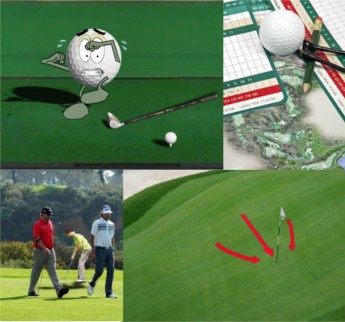When viewed in comparison with many of the other popular sports in the world, golf wouldn't seem to be a game that comes with a lot of fear. If you play baseball, for example, you have to worry about getting hit with a fastball while standing in the batter's box. Or, if you are a football player, you have to worry about getting tackled by a linebacker who you never see coming. The list can go on and on. Many sports bring along very real physical fears.
| GOLF FIXES BY PGA PROS |
|---|
| Causes Of Fear On The Golf Course | Video | Article |
| Overcome Fear Of Frozen Takeaway During Practice Rounds | Video | Article |
| LESSONS |
|---|
| Overcoming Fear In The Golf Short Game | Video | Article |
| Improve Confidence And Control Fear On The Golf Course | Video | Article |
| Overcoming Fear In The Golf Short Game | Video | Article |
| Play Smart Golf: Golf Without Fear | Video | Article |
| Hybrids Can Take The Fear Out Of Golf Fairway Bunker Shot | Video | Article |

In golf, of course, the fear is not of a physical nature. Unless you happen to get hit by an errant shot from somewhere else on the course, you should walk off the 18th green unscathed. However, that doesn't mean that you will be free from fear for the entire day. The fear in this game comes in the way of threats to your score and your performance. Many different situations which will pop up on the course can lead you to feel fearful, including having to hit a long shot over water, or having to hit a short putt with something on the line. Every golfer knows the feeling of being afraid while getting ready to swing – and that is a powerful feeling, even if your fears are not the physical kind.
Generally speaking, golf is not a scary game. It’s not nearly as physical as many other sports, so the risk of injury is lower, and you can usually stroll comfortably around the course from the first tee to the last green. This is part of what makes golf such a popular game – you can play it throughout many different stages of life, even as your physical capabilities gradually change.
So, with that said, why are we writing an article about fear in golf? The fact of the matter is that fear does play a big role in this game, just not in the physical manner that it presents itself in other sports. For instance, fear in baseball may come in the form of having to face a pitcher throwing a fastball more than 90 miles per hour. In golf, the fear is mental rather than physical, as you will see the hazards and obstacles in front of you and wonder if you’ll be able to avoid them successfully on your way to the hole.
With this article, we’d like to take a look at the topic of fear in golf from a number of angles. Even if you only play casual golf and never enter a tournament, you still may find yourself feeling fear from time to time. For the competitive player, those sensations are even stronger, and they can easily interfere with the player’s ability to produce good shots. Not only will we talk about what kinds of fear you will face on the course, but we will also highlight some strategies you can use to get around this issue.
All of the content below is based on a right-handed golfer. If you happen to play left-handed, please take a moment to reverse the directions as necessary.
— When Fear Can Strike in Golf
Often, you’ll feel quite comfortable on the golf course. The shots you will face won’t be too intimidating, you will feel comfortable with your swing, and you’ll be playing with people you know well. On other occasions, however, it’s hard to settle in and find the peace of mind required to play your best. One of the tricky things about fear in golf is that it can seemingly come out of nowhere, and your feelings can change dramatically from shot to shot. The list below touches on some of the common situations that will lead to feelings of fear in your game.

- An intimidating shot. It may be nothing more than an intimidating shot which causes you to feel fear on the golf course. A common example of this kind of situation is a shot that needs to be played over water. For instance, you may find yourself on a par three that measures 150-yards. Normally, without the water to worry about, this shot would be pretty straightforward. You may use a mid-iron or short-iron depending on your personal abilities and conditions, but a normal 150-yard par three is nothing to be afraid of. If you add water to the equation, however, things get a little complicated. With the added pressure of having to carry the ball over water most of the way to the target, you may get nervous and feel the fear that comes with having to strike the ball cleanly in order to be successful. Even a slight miss-hit in this situation could send the ball splashing into the pond. There are plenty of other types of intimidating shots that you can be forced to hit in this game, but the forced carry over water is one that seems to grab the attention of nearly every player.
- Playing in a competition. It can be said that there are two different types of golf – casual golf and tournament golf. While they are technically the same sport, and are played on the same courses, they certainly don’t feel the same. If you have ever played in a tournament before, you already know that the nerves you feel in that setting are far greater than what you feel when playing golf with your buddies. Tournament golf is exciting, to be sure, but feelings of fear will often bubble up as you attempt to play your best when it matters most. One of the things about playing tournament golf that surprises many players is how even the simple shots start to seem difficult under pressure. During a normal round, you might not pay much attention to a short putt for par, but that putt will cause you to focus in a tournament setting. The same can be said of a straightforward chip shot that would typically give you no trouble – that simple chip might not be so easy when something is on the line and a score will be posted next to your name at the end of the day. It is the opportunity to rise to the occasion and play well under pressure that makes tournaments so much fun, but don’t underestimate how difficult they can be.
- Playing in front of other people. For some golfers, it is the act of hitting shots in front of other people that quickly brings fear bubbling to the surface. Those ‘other people’ are usually strangers, as most people are comfortable enough playing in front of their usual group of friends. However, when others are watching, swing technique can quickly go sideways and the results can get ugly. Whether it is being paired with strangers for the round or just hitting on a tee box that is in close proximity to the clubhouse, fear can get in your way if you aren’t comfortable performing in front of others.
- Closing in on an accomplishment. While it’s possible to feel fear and get nervous anywhere on the course, those feelings are particularly common near the end of the round. As you close in on the last few holes of the day, you may find that you start to get a little nervous about your play – especially if you are doing well. For instance, if you are playing a casual round and have a chance to post a new personal best score, you are going to feel nerves associated with that potential accomplishment. Or, if you are playing in a competition and you know you have a chance to win or finish in a high position, the nerves will set in and you’ll have to deal with that hurdle as you make your way toward the last green. One of the things that makes any new accomplishment in golf so satisfying is that you have to work through the pressure of the final few holes to actually get it done.
Fear is an individual thing that will affect golfers differently from one player to the next. One golfer might have no problem hitting shots in front of strangers yet dealing with the closing stretch of holes is a problem. Or, a player might not worry at all about hitting over water, while at the same time dreading the thought of playing in an upcoming tournament. Whatever the case may be for you, get to work on addressing your personal issues and finding a way to deal with them successfully.
— Likely Outcomes When You Are Nervous
Nerves and fear in golf are only a problem if they lead to negative outcomes. If you feel nervous but still hit good shots, who cares? It’s when those nerves start to stand in the way of you reaching your goals that you need to find a solution.
How do you know when fear on the course is standing in the way of your success? Watch for the following –

- A specific miss pattern. This one will take a bit of time to determine because everyone is a little bit different. However, for most players, there is a pattern that governs how they tend to miss when they get under pressure. For instance, you might find that you struggle to make a good shoulder turn in the backswing when you are nervous, and you wind up hitting a lot of pulled shots to the left as a result. Or, it may be that your lower body rotation suffers under pressure, and you hit weak fades by coming over the ball and losing speed through impact. However it plays out, you need to get familiar with your typical miss so you can be aware of it and plan accordingly.
- Hitting the ball fat. You may find that a lot of your shots under pressure are hit fat, especially with short irons. That is often because you will become tentative and careful under pressure, failing to give your swing the speed it needs through the hitting area to make a clean strike. It’s important to commit yourself fully to each shot you play on the golf course, even when you are nervous. That’s not easy to do, of course, so we will talk in the next section about some strategies you might be able to use to stay committed even when the pressure is on.
- Hitting the ball too far. Believe it or not, you may actually hit some of your shots too far when you are feeling pressure. If you manage to get over the hurdle of being tentative and protective while nervous, you could go too far in the other direction and wind up smashing the ball beyond your target. The adrenaline that builds up when you are excited and anxious about a shot can provide an unexpected power boost to your swing. That might be great off the tee, but it’s not such good news when you have a pitching wedge in your hands and you need to dial up the perfect distance for your approach. The players who fare the best under pressure tend to be those who are able to manage their emotions properly and not get too high or too low at any point.
- The dreaded shank. We hesitate to even include this one on the list, because this is the kind of thing you just don’t talk about in golf. It must be mentioned, however, since it is possible that the shank is something you will wind up dealing with when you get nervous. Most shanks are a result of a poor release through the hitting area, where the player ‘holds on’ through impact instead of letting the rotation of the club turn the face over naturally. So, it makes sense that this is something that may happen when you get tight over an important shot in a big moment. To avoid this outcome, you’ll have to find a way to let your release happen just as it would for any other shot.
There is a lot that can go wrong when you are nervous on the golf course. Does that mean all of the shots you hit during a given round will be disappointing? Of course not – you should hit plenty of good ones along the way, as well. Make it a point to pay attention to the mistakes you do make and see which ones you can attribute to pressure.
— Strategies to Overcome Fear
Nerves have been a part of this game for generations. It’s not new to feel nervous as you play golf – it’s only natural if you are even a little bit competitive. You should understand that feeling nervous is not actually the problem – it’s completely okay! There is nothing wrong with feeling nervous when you play golf, and those feelings can actually help you play better in some circumstances. In fact, simply accepting that nerves are a part of the game, and that they are okay, is one of the biggest steps you can take toward better results.
In addition to welcoming the nerves and not trying to fight them off, the points listed below can also help you manage fear better on the golf course.

- Choose an easier path. When you find yourself facing a difficult shot in a pressure situation, consider taking a conservative approach to the shot in order to give yourself extra margin for error. It’s not realistic to think you will hit a perfect shot when you are already nervous, so maybe aim for the middle of the green instead of at the pin cut close to an edge. Or, maybe go down to a three wood off the tee instead of hitting the driver. This kind of strategy is going to be entirely dependent on the situation, of course, as taking a safer route might not always be the best option. When it is a viable choice, however, consider playing it safe and you may find that some of the pressure come off of your shoulders before you even make the swing.
- Put golf in perspective. An excellent way to take the edge off of your emotions on the course is to remember that this is just a game. Sure, it’s fun to play well and you want to do your best, but it is still just a game when all is said and done. There are probably plenty of other important things in your life away from the course, so use a bit of perspective to help yourself relax when it comes time to play an important shot. This strategy isn’t going to automatically remove all of the nerves, of course, but it should help you make a free swing without worrying quite as much about the outcome.
- Get into your routine. One of the things most professional golfers do to handle the pressure they face is to get deep into a pre-shot routine before every shot. Instead of thinking about the pressure and what is on the line, they are preoccupied with decide what club to hit, which line to take, etc. You should build a consistent pre-shot routine on the driving range so you can use it on the course time after time. If you keep your routine consistent – from shots at the start of the round on through to pressure shots at the end – it will offer you some comfort and help you to calm down even when your nerves are at their worst.
Experience is one of the most powerful tools available in the battle against fear on the golf course. Simply by playing more golf, and hitting more pressure shots, you should get better and better at handling yourself when the nerves set in. In fact, you may get to a point where you find it fun to golf under pressure, as the addition of that fear factor will help you focus and make it all that much more rewarding when you do succeed.
— Fear in the Short Game
To wrap up, let’s talk about fear in the short game. It probably shouldn’t have taken us so long to get to this topic, as the short game is maybe where fear is most likely to be seen first. Short game shots require a deft touch, and your touch can be the first thing to go when you get nervous. A lot of dealing with short game nerves comes down to nothing more than experience, but we can offer a few tips in the list below.

- Maintain your tempo. It is your tempo that will likely be the first thing to go in the short game when you get nervous. Your backswing or backstroke will get shorter and you will start to rush the club through the ball without much rhythm. Don’t let that happen. Take a deep breath before the shot and focus on letting the club flow nicely back and through. If you can maintain the same tempo that you have in practice while you are on the course, it is much more likely that your shots will find their target.
- Don’t rush. It is very tempting to rush through short game shots when you are nervous. This is a problem because it will cause you to cut short your routine and miss out on some potentially valuable information. For instance, imagine you are facing a 10-foot putt for birdie that could secure a new personal best score. If you are nervous, you might feel like walking up to the ball, quickly marking it and replacing it, and then sending the putt on its way. This is not a good approach, because you need to take a moment to carefully read the green before making a stroke. Take the extra moment or two to walk to the other side of the hole and properly read the putt. Not only will the read provide valuable information, but it will also give you a second to calm down and get your nerves under control.
- Keep your head still. Even minor head movements can cause big problems in the short game. If you move your head while making a putting stroke or chipping swing, you may not make great contact with the ball – and you might not send the ball in the right direction. It might seem like an easy thing to keep your head still, but it’s quite hard when you are feeling pressure and want to look up to see where the ball is going. During practice, work regularly on mastering the art of keeping your eyes on the ball and your head steady. It’s easier in practice, of course, but that’s the point. Learn how to do it there and that skill will carry over onto the golf course in most cases. Also, it can help to remind yourself right before you hit a short game shot that you need to keep your eyes focused on the ball until it has been struck.
We hope this discussion on fear in golf has helped you form a clearer picture of how fear can affect you, and what you can do about it. The goal here isn’t to completely get rid of fear – it can actually help you play better if it causes you to focus. As long as you accept that some nervousness and anxiousness are part of the game, you should be able to learn how to perform in spite of their presence. Good luck!






